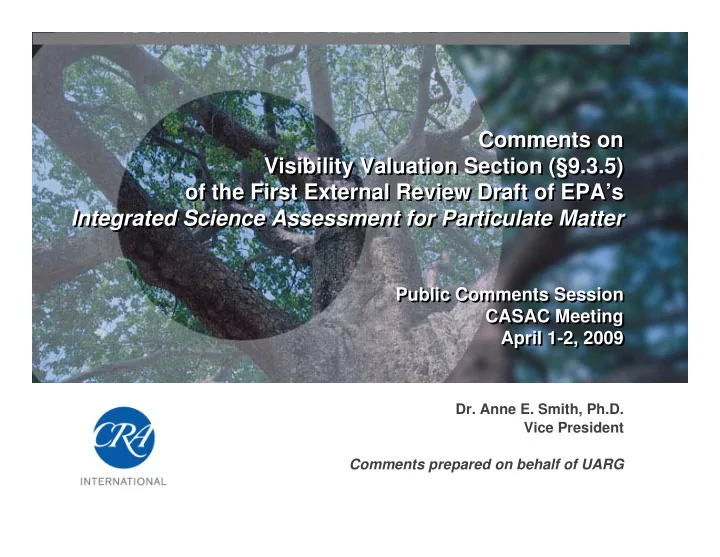

Comments on Comments on Visibility Valuation Section (§9.3.5) Visibility Valuation Section (§9.3.5) of the First External Review Draft of EPA’s of the First External Review Draft of EPA’s Integrated Science Assessment for Particulate Matter Integrated Science Assessment for Particulate Matter Public Comments Session Public Comments Session CASAC Meeting CASAC Meeting April 1-2, 2009 April 1-2, 2009 Dr. Anne E. Smith, Ph.D. Vice President Comments prepared on behalf of UARG
Main Points in My Written Comments Sole focus of rest of my oral comments 1. VAQ Preference Studies do not provide a valid basis for identifying the public’s preference for a visibility standard 2. Two new visibility studies reinforce evidence that results of both preference and valuation studies are “contaminated” by people’s concerns about healthfulness of air. 3. The new property value study, Beron et al. (2001), cannot justify its claim that it has separated health values from aesthetic values. 4. The ISA should acknowledge another new visibility valuation study, Smith et al. (2005, 2006), which provides additional relevant evidence about the interpretation of visibility WTP estimates based on the contingent valuation method. 2
VAQ Preference Studies • Method: Ask a sample of people to look at photographs of their local area of residence – Range of VAQ levels shown in a set of photographs of same vista – Ask them to report whether each VAQ level is “acceptable” or “unacceptable” • Results: Percent who say “unacceptable” increases as VAQ in photographs worsens • Interpretation by Authors (and EPA): VAQ level that 50% of people say is “unacceptable” should be VAQ visibility standard. 3
Example of One VAQ Preference Study: Washington DC (Abt Associates, 2001) 100% 90% 80% Percent "Unacceptable" 70% 60% 50% Say VAQ is 50% “Unacceptable” 40% Abt Results 30% 20% 10% 0% 8 10 12 14 16 18 20 22 24 26 28 30 32 34 36 38 40 42 44 Deciview Implied Range for a VAQ Standard 4
CRA Study’s “Test 1” Was Able to Replicate Abt Results -- Same Range and Ordering of VAQ Were Shown 100% 90% 80% Abt Results Percent "Unacceptable" 70% 60% 50% 40% CRA “Test 1” Results: 30% Replicated Abt’s 20% 10% 0% 8 10 12 14 16 18 20 22 24 26 28 30 32 34 36 38 40 42 44 Deciview 5
CRA Study’s “Test 2” Used Only Photos with VAQs Deemed Acceptable by >50% in Original Survey 100% CRA “Test 2” Results: 90% Highly “acceptable” VAQs in original design 80% Percent "Unacceptable" become “unacceptable” CRA “Test 1” Results 70% (same VAQ range as Abt) 60% 50% 40% 30% 20% 10% 0% 8 10 12 14 16 18 20 22 24 26 28 30 32 34 36 38 40 42 44 Deciview “Test 2” showed only photos with 27.1 dv or less (but in same order as original design) 6
CRA Study’s “Test 3” Added Two Photos with Higher Deciview Levels Than Highest in Original Survey 100% 90% CRA “Test 2” CRA 80% Percent "Unacceptable" “Test 1” 70% 60% 50% CRA “Test 3” Result: 40% “Unacceptable” 30% VAQs in original design 20% become “acceptable” 10% 0% 8 10 12 14 16 18 20 22 24 26 28 30 32 34 36 38 40 42 44 CRA “Test 3” included 2 photos with higher Deciview deciviews than highest in original design (42 dv and 45 dv events do occur on occasion) 7
Conclusions on VAQ Preference Study Method VAQ preference study method is not a scientifically valid basis for setting a visibility standard • VAQ Preference Studies do not reveal a “credible” or “enduring” judgment about what people’s “own eyes tell them is the cutoff between acceptable and unacceptable VAQ.” 1/ • CRA’s research indicates that the preference study method induces people to judge acceptability entirely in relative terms – This calls into question whether an absolute standard of acceptability for VAQ even exists 1/ Quote from the original VAQ preference study, Ely et al ., 1991, p. 3 8
Recommend
More recommend